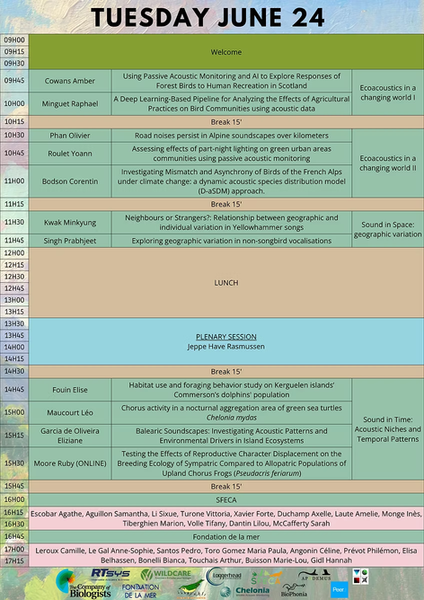
JJBA 2025 | 24-26 Juin 2025
Journées des Jeunes Bioacousticiens 2025 – Résumé de l’événement
La 3ᵉ édition des Journées des Jeunes Bioacousticiens (JJBA 2025) s’est tenue du 24 au 26 juin 2025 à Vernon, en France, et a rencontré un grand succès. L’événement a réuni environ 70 participants venus de 12 pays et 3 continents, dont des étudiants, des jeunes chercheurs et des professionnels issus du monde académique et du secteur privé.
Pendant trois jours, les participants ont pu partager leurs travaux et échanger des idées à travers 30 présentations orales, 23 posters et 9 sessions scientifiques. Le programme comprenait également 3 conférences plénières – deux animées par des chercheurs confirmés et une par une entreprise innovante dans le domaine de la bioacoustique – ainsi que 2 ateliers interactifs :
-
IA et bioacoustique : une introduction à l’intelligence artificielle et à ses applications.
-
Bioacoustique appliquée : démonstrations de localisation sonore et présentation d’équipements.
Afin de rendre la conférence accessible à tous, les frais d’inscription ont été maintenus au minimum et l’hébergement ainsi que les repas ont été offerts à tous les participants présentant leurs travaux. La plupart des sessions ont été diffusées en direct sur YouTube, avec environ une centaine de spectateurs par jour.
La conférence a offert un environnement ouvert et convivial, favorisant l’apprentissage, la collaboration et les échanges entre jeunes bioacousticiens. Suite à ce succès, une nouvelle édition est déjà en préparation pour l’année prochaine.
JJBA 2025
l'ensemble des présentations orales ont été retransmises en direct sur la chaîne Youtube des JJBA.
Communications orales
Les communications orales de 15 minutes sont réparties en différentes sessions scientifiques. Les participants·es dont le résumé scientifique a été accepté par le comité d’organisation auront l'opportunité de présenter leurs résultats scientifiques récents.
Session Posters
En introduction de la session, chaque participant·e débutera par une présentation de son poster (2 minutes par poster).
Conférences Plénières
Trois conférences plénières de 45 minutes (+15 minutes de questions) seront tenues par des bioacousticien·nes confirmé·ées. Ces conférences offriront une occasion unique aux étudiant·es et jeunes chercheurs et chercheuses d'assister à la présentation de travaux majeurs dans leur domaine et d’échanger avec des chercheurs confirmés.




Conférencier·ères invité·es

Jeppe Have Rasmussen
Postdoc, University of Copenhagen
From Clicks to Moans: How Bioacoustics Keep Me Guessing Which Species I'm Studying Today

Michelle Spierings
Assistant professor Leiden University
The Biological Basis of Musicality: A Comparison Between Primates, Songbirds, and Parrots.

Corentin Troussard
Science & Industry Sales Manager RTSYS
Underwater Acoustics in the Age of AI and Robotics: Toward Permanent Ocean Surveillance.
Ateliers
Applied bioacoustics
Michael Maggs, Frontier Labs
Andy Hill, Open Acoustic Devices
AI and bioacoustics
Jeppe Have Rasmussen, University of Copenhagen
Assemblée générale
L'assemblée générale a eu 26 juin à 10:00 afin de discuter de l’avenir du colloque et d’assurer sa pérennité. L’objectif de cette assemblée est de présenter le projet de colloque dans sa globalité, de discuter des points à améliorer en se basant des éditions passées. Une nouvelle équipe s'est formée afin de prendre en charge l’organisation de la prochaine édition.
Événements sociaux
Des pauses régulières ponctueront le colloque pour favoriser les échanges scientifiques. Une soirée "spécialités locales" et une soirée de gala seront également organisées afin de créer des liens entre les participants·es. La transdisciplinarité étant au cœur de ce projet de colloque, l’objectif est de faciliter les échanges entre les scientifiques d’horizons différents dans une ambiance conviviale, enthousiaste et productive.
Équipe d'organisation



Patrick KAGERER
Marianne SARFATI
Justine GIRARDET
Président
University of Iceland
Vice-présidente
Royal Holloway University of London
Trésorière
Université de Toulon, Laboratoire LIS,
CIAN, France et Université de Pavia, Italie



Loanne PICHOT
Salomé MARIN-MARIN
Lucie JEAN-LABADYE
Secrétaire
UMRAE, Université Gustave Eiffel
- CEREMA, Rouen
Membre du comité d’organisation
CEREMA, Rouen
Membre du comité d’organisation
Sorbonne Université

April HOUWELING

Loréna BOISSEAU
Membre du comité d’organisation
Simon Fraser University
Membre du comité d’organisation
Estación Biológica de Doñana- CSIC, Seville, Espagne
















